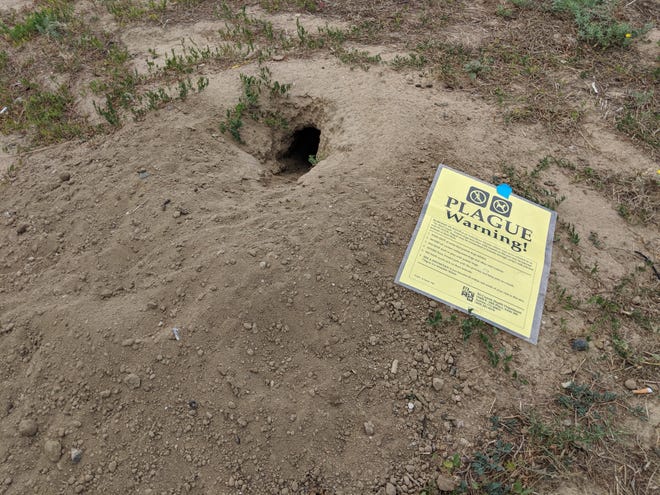A person living in Pueblo County, Colorado, about 100 miles south of Denver infected with bubonic plaguelocal health officials said Monday.
Last week, state and local officials Cases were identified based on preliminary test results.Tristen Garcia, a spokesperson for the Pueblo Department of Public Health and Environment, said in an email Tuesday morning that the infected person has bubonic plague. Previous announcements had referred to it more generally as “plague.” The infection was first reported on Friday. The department said the infected person was hospitalized with bubonic plague but has since improved. Garcia said it’s difficult to pinpoint the source of the infection because plague is endemic locally.
Bubonic plague, which caused historic pandemics in Europe and Asia, is caused by the Yersinia pestis bacteria. The bacteria is transmitted by fleas carried by wild rodents such as rats and prairie dogs. Plague can be contracted when an infected flea bites a person, or when a person touches or scratches the skin of an infected animal.
Most plague cases in the United States occur in the Southwest (northern New Mexico, northern Arizona, and southern Colorado) and the West (California, southern Oregon, and western Nevada). According to the Centers for Disease Control and Prevention (CDC), an average of seven cases of plague occur in the United States each year.
In March, a New Mexico man Died of the plagueThe state health department announced the news. Oregon officials said: Human cases of plague The outbreak began in February. The Oregon case was likely caused by an infected pet cat.
Avian influenza:4th US bird flu case of 2024 occurs in Colorado, CDC says
What are the symptoms of bubonic plague?
Symptoms can develop after an incubation period of one day to one week. whoPlague typically causes sudden fever and chills, severe headache, muscle pain, nausea, and vomiting.
A common symptom is swollen, painful lymph nodes, called “buboes,” which give the name “bubobic” to the most common form of the disease. These nodes can be found in the armpits, groin, neck, or Mayo ClinicBubonic plague blisters vary in size from less than half an inch to about four inches. Bubonic plague is not transmitted from person to person. CDC Said.
Other forms of plague include pneumonic plague, which occurs when bacteria infect the lungs, and septicemic plague, which occurs when bacteria infect the blood. Pneumonic plague is spread by inhaling droplets from an infected person. These droplets remain in the air for an hour after an infected person coughs. Pneumonic plague can also occur if untreated bubonic or septicemic plague bacteria spread to the lungs. Septicemic plague does not spread from person to person.
The WHO estimates that between 30% and 60% of people die from bubonic plague. Pneumonic plague is fatal if left untreated.
According to the CDC, there is no vaccine for plague in the United States. Anyone who develops symptoms of plague should seek medical help immediately. Antibiotics can treat plague, but prompt medical help is needed to avoid severe illness or death, Alicia Solis, infectious disease and emergency preparedness program manager for the Pueblo County Public Health Department, said in a statement.
How can I avoid this?
Wild rodents in the American West often carry the plague. With that in mind, Pueblo County Health Department Officials warned people to remove places where rats can hide and breed near their homes, garages, sheds and recreational areas. Pets should not be allowed to hunt or roam in areas where rats are present, including prairie dog colonies. People should also treat their dogs and cats regularly for fleas. Officials warned that flea collars have not been proven effective against plague-infected fleas. Officials also warned against letting pets sleep together.
You should also avoid contact with dead animals. If you must handle a sick or dead animal, use an insect repellent that contains 20 to 30 percent DEET for flea control, officials say. Use a long-handled shovel to pick up the animal and place it in a trash bag outside.
Health News:Ozempic vs. Mounjaro? Research shows there’s a clear winner when it comes to weight loss.
‘Black Death’
Plague has been identified on every continent except Oceania, but the most endemic countries are the Democratic Republic of the Congo, Madagascar, and Peru. Historically, the disease has devastated the world’s population. In the 14th century, bubonic plague caused the Black Death pandemic, which killed an estimated 50 million people according to the WHO. More than a quarter of Europe’s population died, although some estimates are higher. Subsequent epidemics also occurred in China and India.

Past outbreaks in the United States and misunderstandings
Although plague epidemics have occurred in the United States for decades, they have not killed as many people as they have elsewhere. In 1900, the plague was brought to the United States by ships sailing from rat-infested areas, causing epidemics in port cities such as San Francisco, where racist public health policies led to the Chinese community being falsely accused of bringing the disease and of being particularly susceptible to infection, according to journalist David K. Randall.The Black Death at the Golden Gate.In the mid-1920s, Los Angeles experienced the largest urban epidemic in the United States, killing more than 30 people. At the time, Southern California public health officials blamed it on the “Mexican District,” just east of downtown.
However, the cause was fleas infected with the plague virus that lived on urban rodents, which then transmitted the virus to rodents in the rural West, creating a breeding ground for infection that continues to this day.



